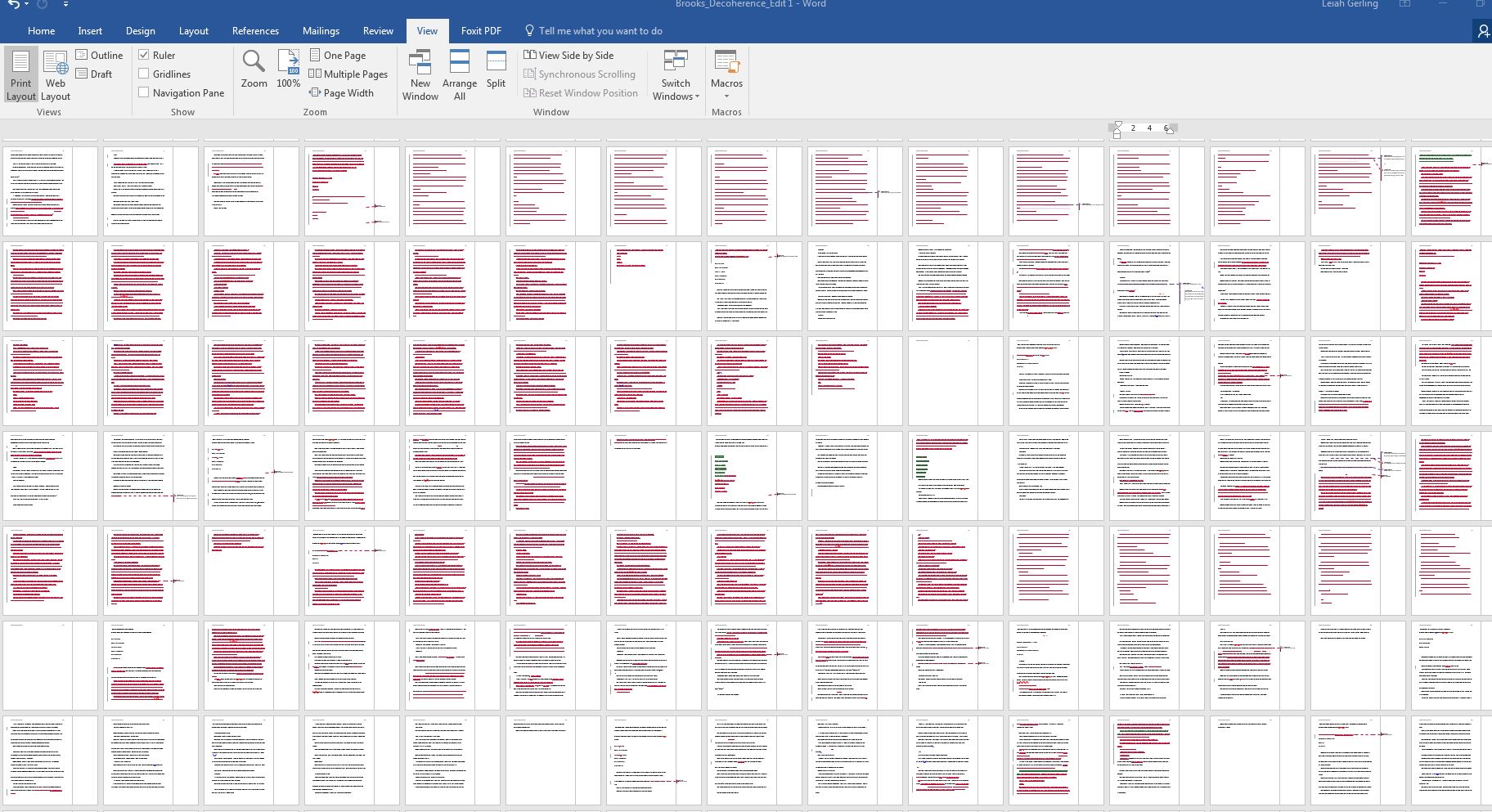
Edits in progress for DECOHERENCE. This is what the manuscript looked like after I addressed all the issues but before the changes were accepted. Read means a scene has been added or cut.
Editing… at some point in an authors career they will receive an editing letter and a set of editing notes from someone. It might be a crit partner, a writing group, a freelance editor, an agent, or an acquiring editor, but the edits will come eventually. When the editing letter arrives the challenge shifts from writing the book to addressing the concerns in the editing letter.
Here’s what works best for me, take and adapt this to your editing style…
1) READ THE EDITING LETTER
Sit down with a glass of water, a box of kleenex, and your favorite comfort snack and read through all the notes. A novel is not a monolith, it’s an ecosystem of words and a minor change on page 17 can have major ramification on page 406. So, read through first and look at the big picture. Make a note of what’s working and what isn’t. Remind yourself that a crit partner can’t abandon you (see: Rules of Writing Friendships), a freelance editor is being paid to support you, and agents and acquiring editors already have a contract with you so they can’t reject you at this stage. Take a deep breath, wipe away your tears, and buck up. It’ll be okay.
2) ADDRESS THE MINOR ISSUES
Save time and brain power by going through and accepting all the recommended changes and fixing all the little things that you can. Typos, comma errors, and questions about word choice (did you mean cay or cave? blooded or bloodied?) can be done quickly. An hour or two and your full manuscript will be half-way edited. It’ll be the easy half, but it’s progress! Reward yourself for a job well done you fabulous person, you!
3) ANSWER QUESTIONS IN TEXT
This is a big one that tends to trip authors up. Editors will leave a question in the inline comments “Why didn’t Selena do XYZ instead of ABC?” Trust me, the editor does not want an email explaining the character choice. The answer needs to be put in the text. If you’re lucky this will mean a few words are added in. If you’re unlucky the editing letter will have exposed a major plot hole and you’ll have to do some serious thinking (or cutting – on deadlines I prefer cutting plot hole scenes).
4) REWRITES AND NEW WRITES
Editing feedback usually comes in 3 waves: first round content edits, second round content edits, line edits. After the first round with a content editor you should expect to write something new. It may be rewriting a clunky scene, it may mean adding a missing scene, but whatever it is there will probably be something to do. By the second round of content edits you should be only doing minor, cosmetic fixes to scenes. And by the line edits you’re quibbling over commas and word choice. The most important thing here is to make sure you budget in the time for these edits. Knowing what to expect helps you better prepare your schedule and time to accommodate the needs of the manuscript.
5) FINAL READ THROUGH
Before handing your manuscript over to the next step (from crit partner to query, from agent to editor, from editor to publication) do a final, non-editing read through of your book. If you can, I recommend loading the manuscript into a program like Calibre so you can produce a digital file you can read on your favorite e-reader. If you’re an indie author going to print I’d recommend getting a proof copy from CreateSpace and going over it with a red pen (in traditional publishing these are the unedited ARCs and proof copies). The goal is to read through and make sure that 1) there are no errors and 2) that you are satisfied with the book you’ve written.
If you find yourself unhappy with a scene consider your deadlines, what time you have left, and whether you’re being a picky perfectionist and should just let the book go to print or whether it needs more editing. One of the hardest lessons for an author to learn is when to stop editing a project and let it go. Perfectionism is the enemy of progress.
6) MOVE ON
Whatever the goal of the project is, once you’ve finished edits it is time to push the manuscript off to the next step in it’s progression and free your time so you can tackle the next thing on your To Do list. Whether that means posting to Tumblr, sharing the work on your blog, sending a query to an agent or magazine, or handing it over to the formatter for publication that’s how you finish edits. You push the manuscript out of the nest, treat yourself to a night of self-care and relaxation, and hit the keyboard the next work day to tackle your next project. Give yourself a pat on the back for a job well done, celebrate with friends, and stop worrying about the finished manuscript. You’ll be happier for it.


